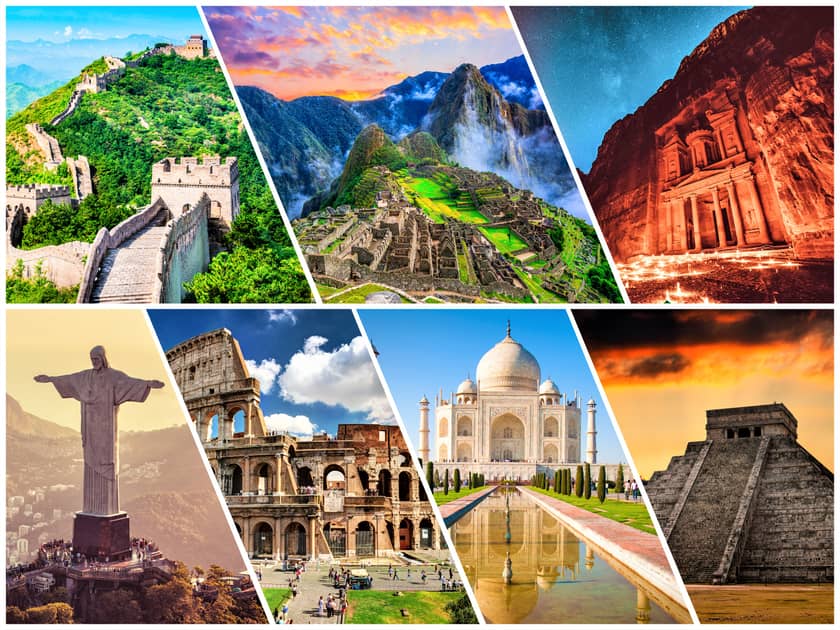When we think about the most impressive places in the world, we usually imagine natural landscapes or modern skyscrapers. But there are also places built by ancient civilizations and more recent societies that continue to amaze us today. In 2007, after a global vote, the “New 7 Wonders of the World” were chosen from a list of 200 monuments. These sites are not only architectural masterpieces but also powerful symbols of culture, history, and human creativity.
1. The Great Wall of China – China
Stretching over 20,000 kilometers, the Great Wall of China was constructed over several centuries to protect the country from invasions. Built by different dynasties, mostly using bricks, stones, and wood, it winds through mountains, forests, and deserts. While it’s not a single continuous wall, its vastness and historical significance make it one of the most extraordinary structures ever built.
2. Petra – Jordan
Hidden among rose-colored cliffs, Petra was once a thriving city and a major trade center of the Nabataean civilization. Its most iconic structure, Al-Khazneh (The Treasury), is carved directly into the sandstone rock and reflects advanced engineering skills from more than 2,000 years ago. Visitors often describe walking through Petra’s narrow entrance, the Siq, as an unforgettable experience.
3. Christ the Redeemer – Brazil
Standing high on Corcovado Mountain and overlooking the city of Rio de Janeiro, the statue of Christ the Redeemer has become a symbol not only of Brazil but of hope and peace around the world. Completed in 1931, the statue is 30 meters tall and welcomes millions of visitors each year who climb up to admire the breathtaking panoramic views.
4. Machu Picchu – Peru
Built in the 15th century by the Inca Empire, Machu Picchu is located nearly 2,500 meters above sea level in the Andes Mountains. This mysterious city was never discovered by the Spanish conquerors and remained hidden until 1911. Its perfectly cut stone buildings and terraces show the Inca’s deep understanding of astronomy, agriculture, and architecture.
5. Chichén Itzá – Mexico
Located in the Yucatán Peninsula, Chichén Itzá was one of the most important cities of the Mayan civilization. Its famous pyramid, El Castillo, was designed to reflect astronomical events. During the equinoxes, the shadows form the illusion of a serpent slithering down the steps—a clever combination of science and spirituality.
6. The Colosseum – Italy
This Roman amphitheater could hold up to 50,000 spectators and was the largest ever built in the ancient world. Used for gladiator fights, public shows, and even mock sea battles, the Colosseum stands as a reminder of the grandeur—and brutality—of the Roman Empire. Although damaged by earthquakes and time, much of its structure still remains today.
7. The Taj Mahal – India
Perhaps the most romantic of the seven wonders, the Taj Mahal was built by Emperor Shah Jahan in memory of his wife Mumtaz Mahal. Completed in 1653, this white marble mausoleum is famous for its perfect symmetry, reflective pools, and detailed decorations. Many consider it the most beautiful building ever constructed.
These wonders remind us that people, even thousands of years ago, were capable of creating things that still inspire us today. If you had the chance to visit just one, which would you choose?
VOCABULARY
- civilization: a group of people with an organized society, culture, and history
- Ancient civilizations like the Mayans left behind incredible buildings.
- structure: a building or construction
- The Eiffel Tower is one of the most famous structures in the world.
- carve: to cut into a surface to create shapes or designs
- The faces of the presidents were carved into the mountain at Mount Rushmore.
- symmetry: the balanced and equal arrangement of parts
- The Taj Mahal is admired for its perfect symmetry.
- panoramic: showing a wide, complete view
- From the top of the mountain, we enjoyed a panoramic view of the valley.
- significance: the importance or meaning of something
- The Colosseum has great historical significance.
- astronomy: the study of stars, planets, and space
- The Maya used astronomy to design their temples.
- mausoleum: a building where someone important is buried
- The Taj Mahal is actually a mausoleum for an emperor’s wife.
ACTIVITIES
1 - Choose the correct answer.
2 - True or False?
3 - Complete the sentences using words from the vocabulary list.
4 - If you could add one new “Wonder” to the list, what would it be and why? Describe the place, where it is, and why it deserves to be on the list.



0 Comentários
Comente, responda, interaja em inglês! Lembre-se: usar o inglês ativamente transforma o aprendizado <3